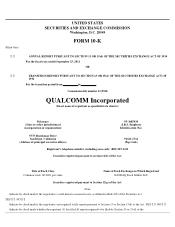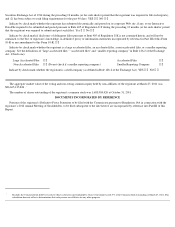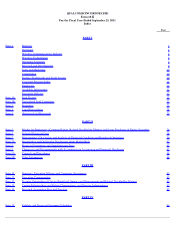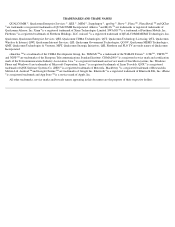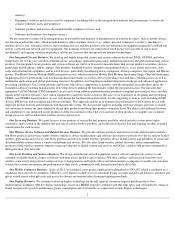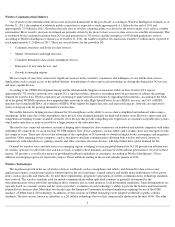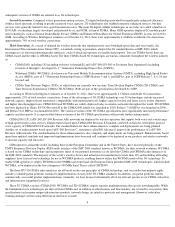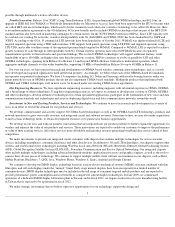Qualcomm 2011 Annual Report Download - page 9
Download and view the complete annual report
Please find page 9 of the 2011 Qualcomm annual report below. You can navigate through the pages in the report by either clicking on the pages listed below, or by using the keyword search tool below to find specific information within the annual report.
subsequent versions of CDMA are referred to as 3G technologies.
Second Generation. Compared to first generation analog systems, 2G digital technology provided for significantly enhanced efficiency
within a fixed spectrum, resulting in greatly increased voice capacity. 2G technologies also enabled numerous enhanced services, but data
services were generally limited to low-speed transmission rates. The main 2G digital cellular technologies in use today are called cdmaOne or
IS-95A/B, a technology largely developed and patented by us, and GSM, a form of TDMA. Many GSM operators deployed 2G mobile packet
data technologies, such as General Packet Radio Service (GPRS) and Enhanced Data Rates for Global Evolution (EDGE) in areas serviced by
GSM. According to Wireless Intelligence estimates as of October 31, 2011, there were approximately 4.4 billion worldwide 2G connections,
approximately 74% of total wireless connections.
Third Generation. As a result of demand for wireless networks that simultaneously carry both high-speed data and voice traffic, the
International Telecommunications Union (ITU), a standards setting organization, adopted the 3G standard known as IMT-2000, which
encompasses six terrestrial operating radio interfaces, each of which incorporates our intellectual property. Two are TDMA-based, three are
CDMA-based and the other is OFDMA-based. The three CDMA-based 3G technologies are known commonly throughout the wireless industry
as:
According to Wireless Intelligence estimates as of October 31, 2011, there were approximately 1.5 billion worldwide 3G connections,
approximately 25% of total wireless connections. Some of the advantages of 3G CDMA technology over 2G technologies include increased
network capacity, improved user experience, compatibility with internet protocols, higher capacity for data and faster access to data (Internet)
and higher data throughput rates. CDMA2000 and WCDMA are widely deployed today in wireless networks throughout the world. TD-
SCDMA
has been deployed in China. EV-DO Revision B in the CDMA2000 family was launched in 2010; Release 7 of HSPA+ was launched in 2009;
and Release 8 of HSPA+ was launched in 2010. The various revisions of the 3G CDMA specifications have significantly increased performance
capacity and data speeds. It is expected that future revisions of the 3G CDMA specifications will provide further enhancements.
CDMA2000 (1X, 1xEV-DO, EV-DO Revision A/B) networks are deployed by wireless operators that support both voice and a wide range
of high-speed wireless data services. Enhancements based upon CDMA2000 Revision E Standard, called 1X Advanced, will further increase
voice capacity of CDMA2000 1X networks. The standardization for these enhancements is complete and deployments are being planned.
Another set of enhancements based upon 1xEV-DO Revision C, sometimes called DO Advanced, improve the performance of 1xEV-DO
Revision A/B networks. The standardization for these enhancements is also complete, and deployments are being planned. Enhancements based
upon these updated standards and improved implementations have been and will continue to be deployed in our products and wireless networks
to increase capacity and data rates.
GSM operators around the world, including those in the European Community and in the United States, have focused primarily on the
UMTS Frequency Division Duplex (FDD) radio interface of the IMT-
2000 standard, known as WCDMA, for their network evolution. WCDMA
is based on our CDMA technology and incorporates many of our patented inventions (as do all of the CDMA and OFDMA radio interfaces of
the IMT-2000 standard). The majority of the world’s wireless device and infrastructure manufacturers (more than 125 and including all leading
suppliers) have licensed our technology for use in WCDMA products, enabling them to utilize this WCDMA mode of the 3G technology. To
enable GSM operators to deploy WCDMA in the 900MHz spectrum band, the European Union permitted IMT-
2000 technologies, which include
WCDMA, to be deployed in the lower frequency 900 MHz band. This is called UMTS900.
The three ITU 3G CDMA radio interfaces are all based on the core principles of CDMA technology, and our intellectual property rights
include a valuable patent portfolio essential to implementation of each of the 3G CDMA standards. In addition, our patent portfolio enables
commercially successful product implementations. Generally, we have licensed substantially all of our relevant patents to our CDMA subscriber
and infrastructure equipment licensees.
These 3G CDMA versions (CDMA2000, WCDMA and TD-SCDMA) require separate implementations that are not interchangeable. While
the fundamental core technologies are derived from CDMA and, in addition to other features and functionality, are covered by our patents, their
specifications each require unique infrastructure products, network design, air interface protocols and management. However, subscriber
roaming amongst systems using different air interfaces is made
4
• CDMA2000, including 1X (including revisions A through E) and 1xEV-DO (EV-DO or Evolution Data Optimized) (including
revisions A through C, developed by 3
rd
Generation Partnership Project Two (3GPP2));
• Wideband CDMA (WCDMA), also known as Universal Mobile Telecommunications Systems (UMTS), including High Speed Packet
Access (HSPA), part of 3
rd
Generation Partnership Project (3GPP) Release 5 and 6, and HSPA+, part of 3GPP Release 7, 8, 9, 10 and
beyond; and
• CDMA Time Division Duplex (TDD), of which there are currently two versions, Time Division Duplex-CDMA (TD-CDMA) and
Time Division-Synchronous CDMA (TD-SCDMA). Both are part of the specifications developed by 3GPP.


